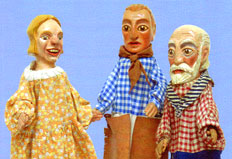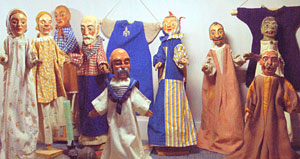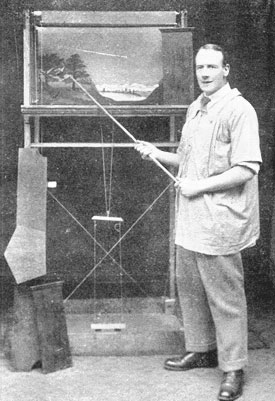| |
Wallace Peat's Wessex Puppets are remembered as
one of the most successful Glove Puppet Companies of the
1930s and can justifiably be regarded as pioneers of
Educational Puppetry in the UK.
Founded in 1931, they performed, intensively and
continuously, until the outbreak of War in 1939.
Most performances were given in schools, mainly in the
South of England and such was their appeal that they
were frequently booked on an annual basis.

Glove Puppets by Wallace Peat
Wallace Peat's particular dream was to introduce young
people to the joy of drama by demonstrating it in a form
they could understand and encouraging them to experiment
themselves with both puppets and model theatres.
The repertoire of the Wessex Puppets included excerpts
from a number of Shakespeare's Comedies, dramatised
versions of traditional English Folk Songs and short
sketches. Each performance concluded with a
demonstration of both the stage and the figures,
together with suggestions on how his young audience
could develop their own shows.

Wessex Puppets Publicity
Brochure
During the War,
Wallace Peat and his wife, Rhonda (Dodie), still found
time to give occasional performances and I was lucky
enough to see one of these in 1942. So when, in
1980, a visitor to our own Theatre in Abbots Bromley,
told me that the Peat's son, Robin, was a Headmaster in
Lichfield and still had his father's puppets, I lost no
time in contacting him. The upshot was, through
Robin Peat's generous co-operation, the Wessex Puppets
were a major attraction in the display we mounted for
the transition of our Theatre into a Puppet Museum and
continued to be so for the next 10 years, until the
collection moved to its present home in the
Staffordshire County Museum at Shugborough, where the
puppets (but sadly no longer the stage due to limited
space), are now displayed.
The figures
represent probably the best preserved complete set of
glove puppets of their period. The heads, which
are immaculate, are well carved in wood and an unusual
perhaps unique feature is that both hands of all the
figures are made on a similar basis to a spring clothes
peg which allows them to pick up small properties, or to
hold hands. Another unusual feature is that all
the figures have an under-garment to which the head and
hands are attached, but on 10 of the 12 main characters,
the outer costumes are removable and a comprehensive
wardrobe allows each figure to play a variety of roles.
Some of these
additional costumes can be seen hanging up at the back
in the photo (top right) of the present display.
The stage is an
excellent example of the ingenuity with which puppeteers
of the day met the problems of portability, weight and
cost. |
|

Wallace Peat's Wessex Puppets
Most of the fit-up folds
down to pack inside the box which forms the base, with
room to spare for some 10 changeable plywood cut-out
scenes as well. Crossed adjustable guy-lines give
the whole frame remarkable rigidity and the roller
proscenium curtain is controlled by a foot pedal so that
it can be operated while both hands are occupied with
figures on stage.
A particularly
fascinating item of historical interest in connection
with the Wessex Puppets came to light in 1986 when a
friend and one-time neighbour of the Peats died at
a ripe old age and among the papers she had kept was a
letter she had received from Wallace Peat dated 16th
November 1937.
This turned out to be a
16 page hand written account of the Peats' appearance on
the fledgling BBC Television
transmissions from Alexandra Palace. The
Producer was Jan Bussell, who was at that time exploiting
the advantage of puppets being able to be shown full
length, while human actors were virtually confined to
head and shoulder close ups.
The document described in
considerable detail their dressing room (much impressed
by their name on the door), the studio itself, with its
banks of powerful lights and scenery painted in grey and
black, the booby-hutch high up, for the Producer
and the Sound and Vision Engineers, the three cameras
themselves (painted battleship grey and mounted on
motor-car chassis) and the telescopic mike boom hovering
above, just out of camera shot.
Peat wrote: "Our
programme included Pistol and the French Soldier
and Clementine plus a few words of introduction.
... of all the grim and ghastly jobs, to go and smile
sweetly and talk naturally to that black hole of the
lens, was like talking to the butt end of a beer bottle.
During rehearsal, with a searchlight shooting straight
at us from behind the camera, the only way we could see
anything at all, was by getting one eye into the shadow
thrown by the puppet onto the backcloth. ...
However, the show went well and to my great joy, I saw
that the Stage Manager was chuckling like anything.
This was a great encouragement, as I reckoned if we
could amuse him we weren't doing too badly."

Wallace Peat Demonstrating
Staging
The discovery of this
document happened to coincide with the 50th Anniversary
of BBC TV (2nd November 1986) and there was some initial
interest shown by the BBC Drama Department, in using
some of Peat's highly detailed account of his
experiences as a basis for an anniversary
production. Unfortunately, this idea never came to
fruition, but the letter remains as a fascinating record
of both the early days of TV Broadcasting and of the
character of a man whose Puppet Company pioneered
new standards in glove puppetry. |
|